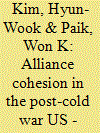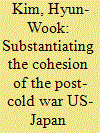| Srl | Item |
| 1 |
ID:
096844


|
|
|
| 2 |
ID:
095033


|
|
|
| 3 |
ID:
108535


|
|
|
|
|
| Publication |
2011.
|
| Summary/Abstract |
After the end of the Cold War, Japan became very active in its security policy. How
can we explain this phenomenon? This essay argues that (neo-) realist settings
(the end of the Cold War, the Taepodong missile launch) have triggered changes
in Japanese domestic security culture, which subsequently affected Japanese
security policy. In spite of rationalist theorists' criticism of the constructivist
approach for not being able to clarify independent and dependent variables, this
essay attempts to elucidate the relationship between security culture and policies
thereof. By utilizing "cultural process-tracing," this paper investigates how cultural
elements become linked and internalized into policymaker-level and illustrates
the causal relationship between these two.
|
|
|
|
|
|
|
|
|
|
|
|
|
|
|
|
| 4 |
ID:
104989


|
|
|
|
|
| Publication |
2011.
|
| Summary/Abstract |
Notwithstanding current disarray, the post-cold war US-Japan alliance has enjoyed its most cohesive status in its history. Japan altered its passive cold war alliance policy and became a more active and equal partner with the United States. Even though there exist many explanations of what has caused this cohesiveness, there is hardly any attempt to substantiate the level of alliance cohesion itself. The purpose of this essay is to demonstrate the cohesion of this alliance by employing concrete operational indicators: homogeneity in goals, threat perception, strategic compatibility and command structure. By investigating how these operational indicators have changed over time, the author proves substantially that the post-cold war US-Japan alliance has developed more cohesively.
|
|
|
|
|
|
|
|
|
|
|
|
|
|
|
|